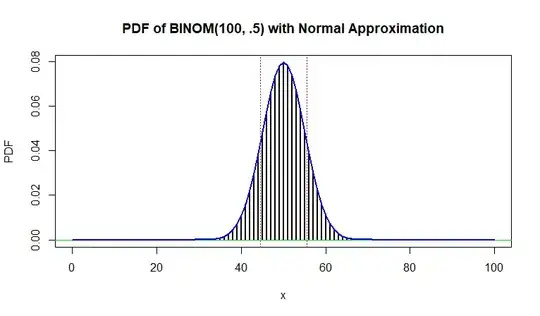Supplemental to answers of @WillM and @AdrianKeister, both (+1).
Sometimes we model essentially discrete situations as continuous.
If you want to be fussy about amount of debt on individual credit cards in the US, then that debt is truly discrete at the one cent level. Even interest charges will be rounded to the nearest cent. But if a continuous model such as $\mathsf{Norm}(\mu = 10000, \sigma=2000)$ is approximately correct for a particular group of cardholders, that is easer to deal with than a discrete random variable with something like $1\,200\,000$ discrete values spaced 1-cent apart.
Also, it is common to approximate $\mathsf{Binom}(n=100, p-1/2)$ as $\mathsf{Norm}(\mu=50, \sigma=5).$ Even though this is perhaps done less frequently now that we have software that deals gracefully with 101 discrete outcomes. The probability of getting between 45 and 55 (inclusive) heads in 100 independent tosses of a fair coin is
exactly $0.72875$ to five places--in R using the CDF pbinom or the PDF (PMF) dbinom.
diff(pbinom(c(44,55), 100, .5))
[1] 0.728747
sum(dbinom(45:55, 100, .5))
[1] 0.728747
A normal approximation, using the 'continuity correction', is $0.72867$ to five places. In practical terms, it would take an enormous number of coin
tosses to distinguish between the two answers.
diff(pnorm(c(44.5, 55.5), 50, 5))
[1] 0.7286679

R code for figure:
x = 0:100; PDF = dbinom(x, 100, .5)
hdr="PDF of BINOM(100, .5) with Normal Approximation"
plot(x, PDF, type="h", lwd=2, main=hdr)
abline(h=0, col="green2")
curve(dnorm(x, 50, 5), add=T, col="blue", lwd=2)
abline(v=c(44.5, 55.5), col="red", lty="dotted")
Formally, working below the measure-theoretic level, a continuous
random variable can be defined in terms of its density function. [WMS 6e, p155], which has $f(x)\ge 0,$ for real $x,$ with
$\int_{-\infty}^\infty f(x)\,dx = 1.$ Probabilities are defined
for intervals $[a,b],$ with $a\le b$ as $\int_a^b f(x)\,dx,$ with the consequence that the probability of any single point is $0.$
